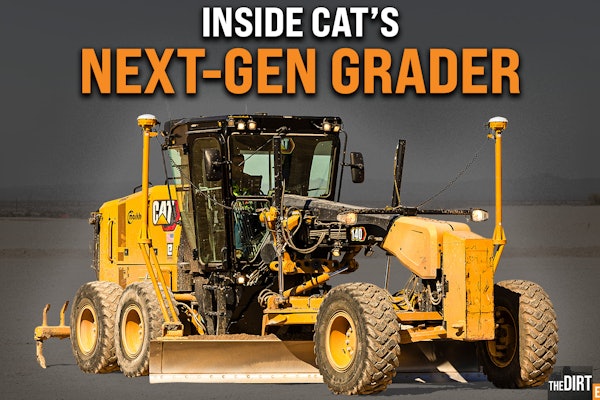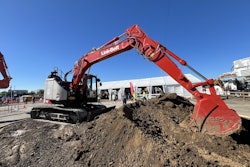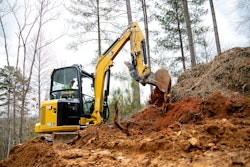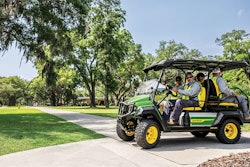You are lugging hard uphill with a heavy load and rpms are dropping even though you’ve mashed the accelerator to the floorboard. All of a sudden there is a big pause … and then – KA-CHUNK – your machine changes gears, your head snaps back and you spill yet a little more dirt from the bucket.
Up until a few years ago this was just the way heavy equipment shifted. It wasn’t bad but it did waste energy (and hence fuel), jar your operator and shock-load the drivetrain.
Today if you are pulling the same maneuver in any machine equipped with one of the new computer-controlled transmissions all you’ll likely feel is a quick, light tug – no wasted torque, no loss of speed, no spillage from the bucket and no whiplash for your operator. Today’s transmissions don’t just shift smoother, they collect information from all over the machine, analyze it and in a split second decide on and execute the optimum shift – perfect shifts, every time, under any condition.
The technology that makes this possible is digital – wrapped up in an electronic control module that has huge benefits for equipment owners. And the impact of this technology has often been overshadowed by bigger developments like Tier II engines and EPA requirements. To correct that oversight we talked to three OEMs about what they’re putting between the torque converter and the wheels and how it can improve your bottom line.
Then and now
Automatic transmissions have been used on heavy construction equipment for decades. But prior to the new generation of computer-controlled transmissions that emerged in the late 1990s, the shift points were fixed for the life of the machine. Settings were optimized for the average load, incline and underfoot conditions and set to shift at a certain rpm, regardless of other variables. Trouble was, construction machines rarely operate in average conditions. Loads change by the ton every few minutes and haul roads and site conditions are constantly changing. Plus, as the machines age, the clutches wear, causing different shift characteristics.
Today sensors throughout the machine read these changing conditions and relay the information back to a central transmission computer, which then decides the optimum timing and energy to put into every single shift. While the specifics of the technology vary somewhat from machine to machine and from manufacturer to manufacturer, they all have in common the use of electronic sensors and computerized calculations.
“In the older transmissions you would use a different orifice or spring and shims to tweak the control valve as best you could,” says Tim Gauer, product support manager at ZF. “You would hope that the shift comfort would be right for the job while not allowing too much clutch fill time or slip time to cause the clutches to heat up and wear out.”
Now software governs the transmission on ZF’s line of Ergopower transmissions, Gauer says. “The software is allowing us to customize the transmission for each application and for each engine and the software learns from itself to better adapt,” he says. It looks at oil temperature, engine speed, the turbine speed of the torque converter. and the output speed of the transmission. It compares all those and adjusts each shift accordingly.”
Cold oil
At Caterpillar, one of the new transmission technologies is referred to as Electronic Clutch Pressure Control, or ECPC in Cat parlance. “Prior to the ECPC what we had was basically a hydraulically controlled transmission that was activated by electric on-off solenoids,” says Wes Jacobson, Caterpillar transmissions product manager. “All the clutch modulation was done with modulation orifices and springs. In those you were stuck with a single modulation characteristic for all operating conditions. With the ECPC control we have the ability to adjust modulation based on a number of different inputs.”
Transmission oil temperature is one such input. At start up, cold oil is thick and difficult to pump through the system. “With the advent of electronics and temperature sensors we adjust the parameters on the clutch modulation to achieve a better shift under cooler oil conditions,” Jacobson says. “In the past with hydro-mechanical transmissions you might shift from neutral to first gear and nothing would happen at first and then it would engage suddenly. Now the valves are opened up so you don’t have the delay and you have a better initial engagement.”
Engine load
Another constantly changing condition that sensors monitor is the load on the engine.
“If you are accelerating a wheel loader up an incline and you don’t want to have a torque interruption, but the engine is under lug and it’s time to shift, we will aggressively engage the clutches to complete the modulation,” Jacobson says. “If you are going down a slope and the engine is not under a lot of load, then we’d back off on the clutch modulation because if you kept it the same as before you would have an aggressive shift. Under a lighter load we would have a more gradual clutch modulation.”
On its wheel loaders, Volvo uses what it calls an APS mode selector. This involves a dial in the cab that the operator can set to four different load characteristics from light to heavy. ” It adjusts the shifting points of the transmission,” says Dan Snedecor, a product marketing specialist for Volvo’s wheel loaders. “If you are in a very light material handling job on a hard-packed, flat surface it allows the machine to shift up to fourth gear very quickly so that he can get to his traveling speed very fast. This in turn will reduce fuel consumption because you’re not holding a gear longer than you need to. You don’t have to wind up the engine for the next shift. You use a heavy setting if you are in the mud or climbing a steep grade where rolling resistance is high.”
The new articulated haulertransmissions have also tackled the problem of a machine trying to hunt for the right gear when struggling to pull a load up a hill. “If there is a lot of gear hunting and the transmission is constantly shifting gears, the electronics monitor this,” says Buddy Goodman, an articulated truck specialist at Volvo. “If there are three upshifts and downshifts within 15 seconds it will actually engage the gear shift inhibitor function automatically and lock into the lower gear so the transmission is not constantly upshifting and downshifting and shocking the geartrain and the operator.”
Clutch slippage
In an ideal world clutches would meet with the minimum required energy, turn in perfect unison and never wear out. And while this ideal is rarely realized, today’s electronically monitored transmissions aim at achieving a similar end result.
“We specify different modulation rates depending on what shift is being performed,” says Dave Spurlock, a transmission engineer at Caterpillar’s wheel loader transmission unit. “Second gear reverse to second gear forward will have a different modulation than a second gear forward to third gear forward shift. We also have closed-loop modulation control, where we monitor the input and output speeds of the transmission to calculate how the clutches engage and how much slippage there is at any time and we adjust the modulation rate or pressure rise to get that clutch slippage where we want it. In the past we just controlled the pressure rise rate. Today we actually control the clutch engagement rate.”
The benefit, Spurlock says, is that it improves shift quality on certain shifts without generating excessive clutch energy on other shifts. You get smoother operation, less material spillage, less drivetrain shock loading and better life from your clutch wear materials. In some cases, the clutch energy may be reduced as much as 50 percent.
Compensating for clutch wear
As machines age, clutches wear down. This increases slippage, creates longer intervals between gear engagements and reduces the drive train efficiency. Toward the end of a transmission’s life, the shifting can become jerky and bothersome. In different ways, all the OEMs we talked to have solved this problem using transmission electronics.
ZF uses what it calls AEB software to “read” clutch wear. “If the transmission is new, the clutch thickness and the coefficient of friction of each disc lining is a certain amount. After many hours that has changed,” Gauer says. “By running the AEB you can better match up the transmission software with those hours. That’s not to say that the transmission lasts longer, but at a minimum you will get a more comfortable useful life out of it.”
Volvo’s pulse width modulation monitors ground speed, operator input (what his foot’s doing on the pedal) and then balances the pressures and speeds of the gears to enable the pressures to come up or go down to eliminate clutch slipping, Snedecor says. Additionally the electronic sensor monitors slipping and if slipping occurs, pressures are increased. “If slipping persists, for whatever reason – operator error, or speeding downhill – then an engine speed restriction is activated automatically. “We’ll pull the engine back so you don’t accidentally damage the transmission,” he says.
As clutches wear they require more oil and increase the distance the piston travels to get the same pressure. Older transmissions had fixed oil-flow rates. “On electronically controlled transmissions we use what’s called adaptive fill to compensate for clutch wear,” says Caterpillar’s Jacobson. “As clutches wore out it took longer to fill the oil and resulted in shift hesitation or torque interruption. With the newer controls we adjust by putting more oil in at a faster rate so the shift time stays the same.”
Reduced complexity
While the software that monitors and governs all these transmissions may be extremely complex, it has actually led to a beneficial reduction in the complexity of the mechanical components that carry out the transmission’s functions. “The hydraulic piece of the control system has been drastically simplified, and is standardized across the Ergopower range” Gauer says. “There used to be a myriad of valving, springs, orifices and shims to correctly modulate shift pressure. The modulation is now accomplished with software that precisely controls current flow to the proportional valves. That makes it easier to maintain a machine.”
“There is an individual modulation valve for each clutch today,” Spurlock says. “It is an electro-hydraulic valve where the pressure going to the clutch is proportional to the current going to it. The valve is very small and simple. Most of the logic or intelligence is contained in the software that controls it. Each clutch has a separate valve that can be controlled independently. Previously we had one big valve that controlled the pressure to all of the clutches. It had lots of springs, orifices and multiple spools, and it got pretty complex. So when it came time to do rebuilds you had a lot of labor involved. With the new style valves in a lot of cases your rebuild is less expensive.”
Software and diagnostics
As with any new technology, the new transmissions come with some changes in the maintenance requirements. The electronic control units and the software in them are pretty much plug and play. Customers don’t get involved with the programming, although changes to the shift parameters can be made by OEMs.
The ability to diagnose transmission conditions and problems has also become much easier to do with new technology. “The way we have the system set up today we actually protect against catastrophic failure,” says Volvo’s Goodman. “Say if one of the shift valves is blocked with dirt and you can’t get enough pressure to the clutches and we see too much speed difference. We will actually kick the transmission down to the lower gear to protect it from burning up the clutch. So instead of having to ruin an expensive transmission, you replace a $10 part and you’re back up and running the next day.”
“Today there are more diagnostics onboard the machine,” says Rick Lippert, product support division, Caterpillar drivetrain parts products group. “Repairs are much simpler and straightforward. Problems are instantly identified. There isn’t any complex or time-consuming troubleshooting. Instead of spending several hours diagnosing a transmission problem, now it’s down to a few minutes.” And thanks to in-cab displays and warning lights, you can call and tell the service tech exactly what the problem is, so the techician doesn’t waste a trip to the site or fail to bring the proper repair part.
Keeping a clean machine: monitoring maintenance becomes more critical
While new transmissions are becoming simpler and easier to diagnose, that doesn’t mean you can ignore their service needs. Oil change intervals have been extended from 500 to 1,000 hours in many cases, but the need for contamination control has increased.
“The electro-hydraulic valves are more sensitive to contamination,” Spurlock says. “These valves are much finer. We’re using a half an amp or an amp to control the valves. There is not a lot of energy there. And when you introduce electricity to a hydraulic system you induce some magnetic force, which attracts dirt.”
Using the right oil and the right filter are also critical. “Don’t use engine oil in your transmission. That is bad,” Spurlock says. “The job of oil in an engine is to reduce friction. If you minimize friction in a transmission you’ve got a problem. You’ve got clutch packs that rely on friction to do their job.” Multi-grade viscosity transmission oils are now available that help transmissions function better in a variety of temperatures.
Regularly scheduled oil samples are also a good idea. Pay special attention to the particle counts. “Particle counts are very important in transmission samples,” Lippert says. “There are a lot of materials that don’t show up in a wear metal analysis that would show up in a particle count, like friction material. Wear metal analysis requires very small particles. If there is some sort of failure generating fairly large particles a wear metal analysis might not pick it up. A particle count would.”
The payoff: smooth shifting equals better profits
None of the sources we talked to would say machines with the new transmissions last longer or save more fuel than those of an earlier generation. But in the field customers and dealers are reporting transmissions are beginning to last longer and require less intensive rebuilds. And there’s no doubt better shift quality has a positive impact on cycle times and productivity.
“You don’t have to suffer with rough shifting when the machine is unloaded versus shifting correctly when it is fully loaded,” Gauer says. “You have a transmission that’s shifting almost as smooth as some of the best car transmissions. There is no degradation of shift quality just because it is transferring a lot of torque in a heavy-duty application. That gives you more control, especially when operating a wheel loader. You’re cycling the transmission back and forth into the pile and back out, and if the transmission is operating smoothly you can operate the machine in a more efficient manner.”
“Improving the duty cycle for a loader is a key consideration,” says Martin Meissner, marketing and communications manager for ZF. “With a smoother transmission you’ve got less driver and operator fatigue. You can concentrate on what you’re doing. You don’t have to worry about selecting the right gear for the gradient. That’s taking those shifting decisions out of your hands and putting them into the hands of the computer.”









